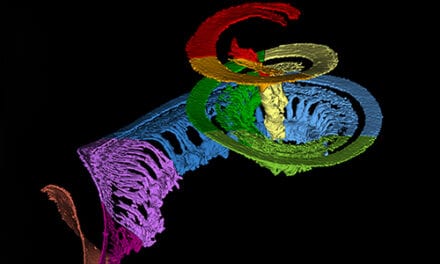The number of hearing-impaired infants and toddlers who are successfully aided by technological devices, such as hearing aids and cochlear implants, continues to grow, but there are still unknowns about these childrens’ speaking abilities, according to an expert from Purdue University, Lafayette, Ind.
A new assessment tool, a game-like activity to monitor early auditory-guided speech development in infants and toddlers, is available for speech-language pathologists, says David Ertmer, the tool’s co-creator and an associate professor of speech, language, and hearing sciences.
"We have universal newborn hearing screenings, which are mandatory in more than 40 states, to thank for identifying hearing issues immediately. Some children receive hearing assistance when they turn 1," says Ertmer, who specializes in early speech and language development in children with hearing losses. "Given the growing number of infants identified with hearing loss through newborn hearing screenings, there is a pressing need for a reliable and practical way to estimate how improved hearing affects listening and vocalizing during the first years of life."
To address this need, Ertmer and Carol Stoel-Gammon, a professor at the University of Washington, developed a test called the Conditioned Assessment of Speech Production (CASP). A description of the tool and field testing results were published in a recent edition of The Volta Review.
Infant vocalizations such as grunts, cooing and laughter emerge during the first six months of life. Well-formed syllables with consonants and vowels, which sounds like babbling, begin to emerge at 5 to 10 months of age. Toddlers begin to produce more complex syllables soon after that and eventually say single words around their first birthdays.
This process is called vocal development, and it lays the foundation for meaningful speech, Ertmer said. Children with moderate to profound hearing loss are usually delayed in vocal development.
"This assessment tool was designed to help speech-language pathologists and audiologists evaluate whether hearing aids and cochlear implants are helping children through the levels of vocal development efficiently," Ertmer says. "Working with infant and toddlers can be tricky because they are often shy and not inclined to vocalize on request. Although parents hear the child vocalizing throughout the day, they do not have the training needed to recognize subtle changes in vocalizations." CASP was designed to find a way to encourage toddlers to imitate their parents’ vocalizations during a play activity."
To interpret the results, the clinician phonetically transcribes what the child says and evaluates how closely the child’s attempts match the increasingly complex and speechlike vocalizations from the CASP. The 5-minute procedure is repeated every 3 to 4 months to monitor speech development after hearing aid or cochlear implant fitting.
"When we tested the CASP tool, we found that scores increased with age and with sensory aid experience," Ertmer says.
To read the entire story, click here.
[Source: Science Daily]




